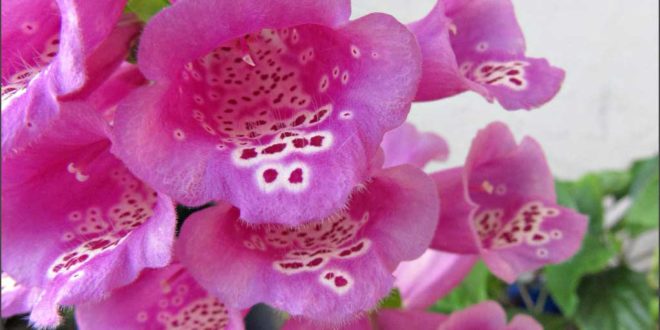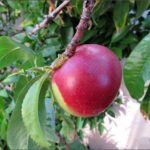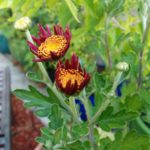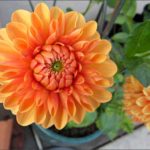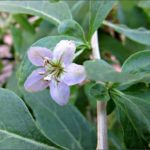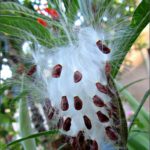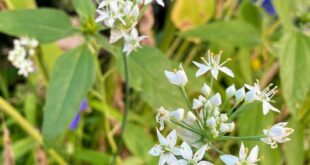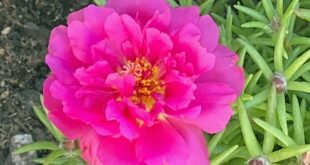This past June was very hectic and I spent little time in the garden.
I have the drip irrigation working again in the backyard. Marie is very grateful because I will be on vacation and she does not want to water the 100 plants and trees on that system. I had a leak from behind the hose bib and had to repipe to remove the sprinkler backflow preventor (since we no longer have a lawn).
We will have a lot of tomatoes ready during late July and then into August.
This past spring my brother Adam brought me a Panoche Fig tree from his garden. The tree is doing very well now with lots of new leaves (now that I water it and moved it from the hottest side of the garden).
Last of the Apricots
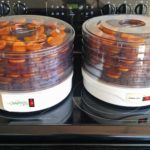
Our Blenheim apricots were ready about two weeks early. We ate our fill and shared the fresh fruit with others. The rest we dried this year.
Dehydrating apricots is simple. The fruit has a seam on one side and you split the fruit on that seam using a knife. To lessen browning of the fruit due to oxidation, You put the fruit in bowl with either lemon juice or ascorbic acid mix. You dry the fruit overnight. Store in freezer bags and place either in a dark cupboard, refrigerator or freezer.
Last of the plums
Last of the nectarines
Limes
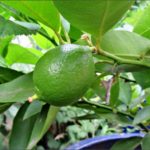
This year is a bumper crop of limes. Our Bearss Lime tree is about 4 years old. It is the only citrus that we grow in a container but it is a very large pot. The tree is about 5 feet tall now.
In 2015 the tree was suffering from citrus leaf stress (where leaves get curled and fall off thus hurting the crop. This past fall I aggressively removed all the affected leaves and this spring new leaves grew back.
Dilly Beans and Carrots
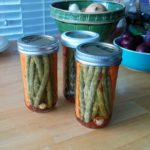
Marie taught me this recipe many years ago. I love the combination of crisp green beans and carrots in vinegar flavored with dill seed, garlic, and chile pepper flakes.
The recipe has a couple of challenges: You have to trim the green beans to be the same height; and you have to pack the beans and carrots into the jar.
Mojo de Ajo (Roasted Garlic in Olive Oil)
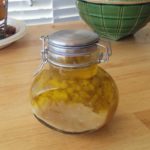
I love growing garlic and elephant garlic in my Sunnyvale garden. They are easy to plant; hardy to drought and frost; they produce beautiful flowers (if you let them) and they produce garlic.
The harvest process is not difficult but it takes some time: You stop watering the garlic for a few weeks; pull up the plant; let it dry for a few more weeks (preferably in a cool dark location).
In our household, there is trouble with this process. A dozen head of Garlic drying in the kitchen smells very potent (or stinks depending on who is telling the story). Ditto on storing it in a spare bedroom. Storing it in a small tool-room was a no-go: It adjoined the craft studio and the smell was infiltrating the fabric. The current solution is outside in a box that stores the patio cushions in the wet season.
Summer Flowers: Mums
Summer Flowers: Foxglove

For several months this spring, dozens of identical plants starting growing in a number of pots throughout the garden. I could not identify the plant by its leaves.
Finally this June, the flowers appeared. It was foxglove. I don’t remember planting foxglove. I grew a foxglove plant last year. I thought they were biennial (meaning the foliage grows one year and the second year the flowers appear. That is not this case.
Summer Flowers: Verbascum

This is the second year for our Verbascum plant. Just like last year it produces a very showy flower stalk. This year we also have some pioneers from seed appearing in adjacent pots.
Tall, upright flower spikes with small bright flowers bloom over a long period and create vertical accents in the garden. Leaves are often fuzzy and cast with a silvery sheen.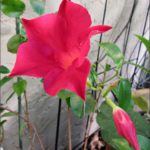
Our Mandeville vine is doing well now that it is on regular drip irrigation. A trellis mandevilla requires rich, well-drained soil for optimal growth. Plant it in a location where it receives partial sun and sufficient air circulation to prevent mildew. Place the plant close to a fence or trellis for support, or, if it’s a potted plant, place a stake in the container. Bring the plant inside when temperatures dip below 45 degrees Fahrenheit.
Summer Flowers: Orange Dahlia
Goji Berry Flowers
Summer Flowers: Liatris
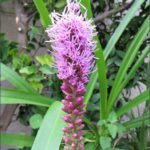
There’s probably nothing more versatile and easy to grow in the garden than liatris blazing star plants (Liatris sp). These 1 to 5 feet tall plants emerge from mounds of narrow, grass-like leaves. Liatris flowers form along the tall spikes, and these fuzzy, thistle-like blossoms, which are usually purple, flower from the top to the bottom rather than in the traditional bottom to top blooming of most plants. There are also rose colored and white varieties available.
Growing liatris plants is easy. These prairie wildflowers provide many uses in the garden. You can grow them nearly anywhere. You can grow them in beds, borders and even containers. They make excellent cut flowers, fresh or dried. They attract butterflies. They’re relatively pest resistant.
Summer Flowers: Spider Lily
Milkweed Seeds
Summer Flowers: Kangaroo Paw
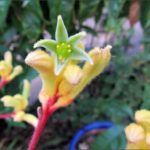
Our kangaroo paw plant is very hardy. The flowers are spectacular and last a very long time. The overall colour of the flowers is influenced by fine coloured hairs which cover the flowers and, sometimes, part of the stalk. The flowers appear over spring and summer.
The flowers are pollinated by birds. The long flower-stalks usually rise above the undergrowth and ‘advertise’ the presence of nectar in the flowers. The stalks also provide a perch for visiting birds.
The shape of the flowers and the position of the pollen-bearing anthers is a feature which allows pollen to be deposited on the head of feeding birds. This pollen is transferred from flower to flower as the birds feed. Different species usually deposit pollen on different areas of the birds’ head. This means that pollen from one species is unlikely to be deposited in the flowers of another species.
Who is nibbling the tomatoes?
Our tomato plants are doing well.
Something is nibbling some of the tomatoes when they get ripe. Whatever it is, has now starting gnawing on the winter spaghetti squash. I took a photo this evening and will compare tomorrow morning. If it is eaten during the day then it is likely squirrels. If it is being eaten at night then it is rats.
